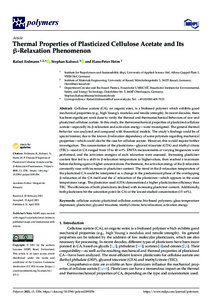| dc.date.accessioned | 2023-06-09T12:45:17Z | |
| dc.date.available | 2023-06-09T12:45:17Z | |
| dc.date.issued | 2021-04-21 | |
| dc.identifier | doi:10.17170/kobra-202306098199 | |
| dc.identifier.uri | http://hdl.handle.net/123456789/14811 | |
| dc.language.iso | eng | |
| dc.rights | Namensnennung 4.0 International | * |
| dc.rights.uri | http://creativecommons.org/licenses/by/4.0/ | * |
| dc.subject | cellulose acetate | eng |
| dc.subject | plasticized cellulose acetate | eng |
| dc.subject | bio-based polymers | eng |
| dc.subject | glass temperature depression | eng |
| dc.subject | plasticizer | eng |
| dc.subject | glycerol triacetate | eng |
| dc.subject | triethyl citrate | eng |
| dc.subject | beta relaxation | eng |
| dc.subject | activation energy | eng |
| dc.subject.ddc | 540 | |
| dc.subject.ddc | 600 | |
| dc.subject.ddc | 670 | |
| dc.title | Thermal Properties of Plasticized Cellulose Acetate and Its β-Relaxation Phenomenon | eng |
| dc.type | Aufsatz | |
| dcterms.abstract | Cellulose acetate (CA), an organic ester, is a biobased polymer which exhibits good mechanical properties (e.g., high Young’s modulus and tensile strength). In recent decades, there has been significant work done to verify the thermal and thermomechanical behaviors of raw and plasticized cellulose acetate. In this study, the thermomechanical properties of plasticized cellulose acetate—especially its β-relaxation and activation energy—were investigated. The general thermal behavior was analyzed and compared with theoretical models. The study’s findings could be of special interest, due to the known β-relaxation dependency of some polymers regarding mechanical properties—which could also be the case for cellulose acetate. However, this would require further investigation. The concentration of the plasticizers—glycerol triacetate (GTA) and triethyl citrate (TEC)—used in CA ranged from 15 to 40 wt%. DMTA measurements at varying frequencies were performed, and the activation energies of each relaxation were assessed. Increasing plasticizer content first led to a shift in β-relaxation temperature to highervalues, then reached a maximum before declining again at higher concentrations. Furthermore, the activation energy of the β-relaxation constantly rose with increases in plasticizer content. The trend in the β-relaxation temperature of the plasticized CA could be interpreted as a change in the predominant phase of the overlapping β-relaxation of the CA itself and the α′-relaxation of the plasticizer—which appears in the same temperature range. The plasticizer used (GTA) demonstrated a higher plasticization efficiency than TEC. The efficiencies of both plasticizers declined with increasing plasticizer content. Additionally, both plasticizers hit the saturation point (in CA) at the lowest studied concentration (15 wt%). | eng |
| dcterms.accessRights | open access | |
| dcterms.creator | Erdmann, Rafael | |
| dcterms.creator | Kabasci, Stephan | |
| dcterms.creator | Heim, Hans-Peter | |
| dc.relation.doi | doi:10.3390/polym13091356 | |
| dc.subject.swd | Cellulose | ger |
| dc.subject.swd | Celluloseacetate | ger |
| dc.subject.swd | Energie | ger |
| dc.subject.swd | Aktivierung | ger |
| dc.subject.swd | Polymere | ger |
| dc.type.version | publishedVersion | |
| dcterms.source.identifier | eissn:2073-4360 | |
| dcterms.source.issue | Issue 9 | |
| dcterms.source.journal | Polymers | eng |
| dcterms.source.volume | Volume 13 | |
| kup.iskup | false | |
| dcterms.source.articlenumber | 1356 | |


